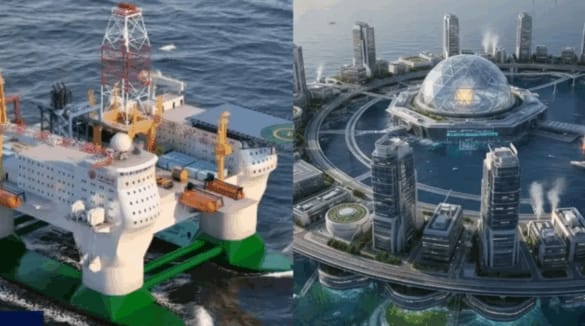China is building a mobile, self-sustaining floating artificial island engineered to withstand nuclear blasts. Designed as a deep-sea research platform with twin-hull architecture, it can house about 238 people for four months without resupply. Planned for operation by 2028, the project blends science goals with clear strategic, maritime implications.
China is advancing a first-of-its-kind deep-sea platform described as a floating artificial island capable of surviving extreme shocks, including nuclear blasts. The semi-submersible, twin-hull facility is slated to operate in far-sea conditions and endure super-typhoons, positioning it as both a scientific asset and a potential strategic node in contested waters. Researchers have highlighted its metamaterial-based structural innovations and sandwich-panel design intended to dissipate intense shock waves, converting destructive forces into manageable pressure, a hallmark of nuclear-blast resilience.
The platform, often referenced as the Deep-Sea All-Weather Resident Floating Research Facility, reportedly displaces around 78,000 tonnes, approaching the scale of China’s newest aircraft carrier in footprint. Its endurance profile is central: the island is designed to support roughly 238 personnel for up to four months without external resupply, enabling long-duration missions in distant ocean regions. Dimensions cited in technical notes place the structure at roughly 138 meters long and 85 meters wide, engineered for stability, modularity, and heavy-weather operations.
Key highlights
-
Nuclear-resilient design using metamaterials and shock-damping sandwich panels to withstand extreme blasts
-
Semi-submersible twin-hull architecture for all-weather, far-sea deployment and super-typhoon endurance
-
Approximately 78,000-tonne displacement, with dimensions near 138m by 85m for large-platform stability
-
Capacity to support about 238 people for four months without resupply, enabling extended missions
-
Operational target around 2028, aligning with China’s push for far-sea scientific infrastructure
-
Potential dual-use implications amid strategic maritime competition and contested ocean regions
-
Focus on deep-sea research, ocean observation, and long-duration resident scientific operations
-
Self-sustaining systems designed for energy, storage, and logistics autonomy at sea
Implications extend beyond research. A long-residency, mobile, nuclear-resistant platform introduces a new class of ocean infrastructure that could anchor sensors, labs, and logistics for far-sea operations. Its deployment may reshape maritime surveillance, scientific cooperation, and power projection dynamics, intensifying debate on the line between civilian science and dual-use capabilities in the Indo-Pacific.
Sources: South China Morning Post, The Indian Express, News18, Moneycontrol, Firstpost.
